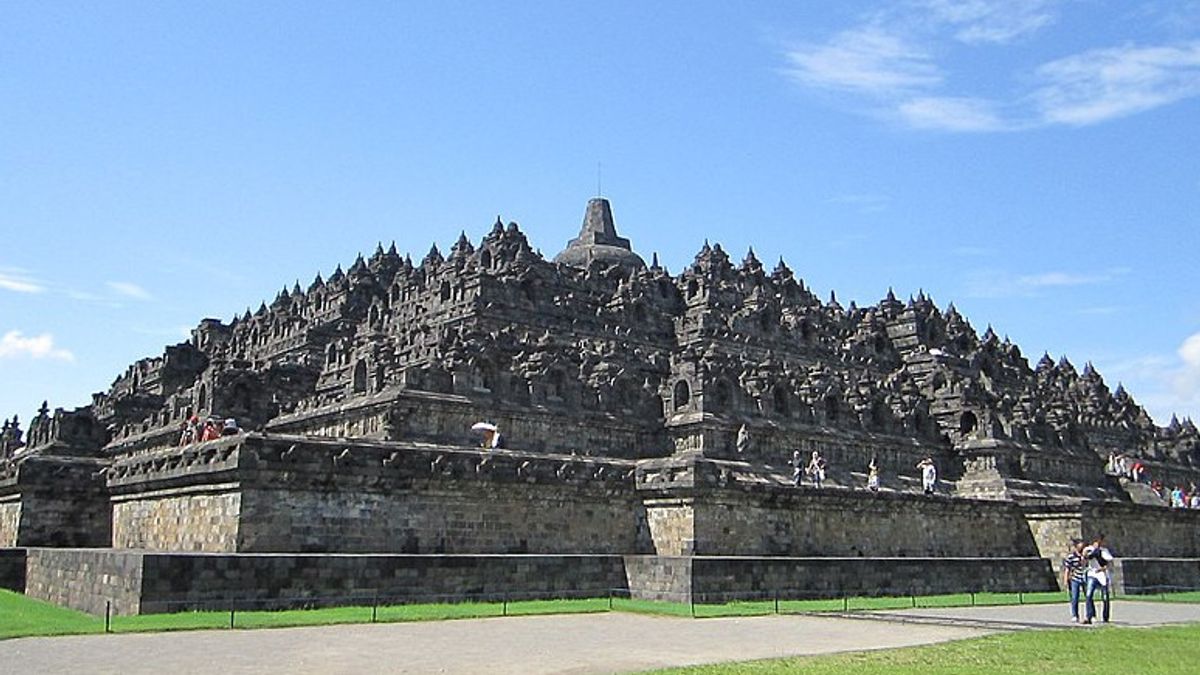JAKARTA – The announcement of the Borobudur Temple ticket price increase by the Coordinating Minister for Maritime Affairs and Investment, Luhut Binsar Pandjaitan on June 4, amounting to Rp. 750 thousand for domestic tourists and US$ 100 for foreign tourists immediately sparked controversy. This figure is considered too expensive, even though the actual cost of conserving a cultural heritage building as high as 35.40 meters which is composed of two million pieces of stone on top of the dune hill is also not cheap.
The reason highlighted for increasing the ticket price to go to Borobudur Temple is for the sake of conservation. It is hoped that through expensive tickets, damage to Borobudur due to the density of tourist visits can be minimized. Automatically with expensive tickets, visitors will be selected. Only tourists who really want to enjoy the ins and outs of Borobudur, which has 10 levels with 1,460 story reliefs and 1,212 decorative panels can climb to its peak.
"We also agree and plan to limit the quota of tourists who want to go up to Borobudur Temple to 1200 people per day, with a fee of 100 dollars for foreign tourists and 750 thousand rupiah for domestic tourists. Especially for students, we only charge 5000 rupiah. Meanwhile, to enter the Temple Area, you will still follow the prevailing prices. This step is solely done in order to preserve the historical and cultural wealth of the archipelago," said Luhut's announcement, which was uploaded to the Instagram account @luhut.pandjaitan.

It is also added that all tourists who go up to Borobudur Temple must use a tour guide, who is a local resident around the temple area. This is for the sake of absorbing job opportunities, as well as fostering a feeling of belonging to the cultural heritage area.
Causes of Damage to BorobudurSince it was discovered by Sir Thomas Stanford Raffles in 1814, Borobudur Temple has been restored twice. The first restoration was carried out by Theodoor van Erp, a Dutch soldier who was also an engineer and was very enthusiastic about the world of archeology. It took Van Erp four years to restore the ruins of Borobudur, from 1907 to 1911.
The second restoration was carried out at the initiative of the Government of Indonesia through the Minister of Education and Culture, Daoed Joesoef. Indonesia collaborated with UNESCO to restore Borobudur for 10 years, 1973-1983 to reveal the shape that can be enjoyed today. In 1991, Borobudur Temple was designated a World Heritage Site with number C.592.
Since it was last restored in 1983, millions of people have climbed the temple with a Buddhist background, which was built during the Syailendra dynasty in the VIII-IX centuries AD. Downstream of tourists in massive numbers, it is certain to cause damage to several parts of the Borobudur Temple.
“Especially on the stairs. Since it was last restored in 1983, the wear of the stone on the steps of Borobudur Temple has reached 4 cm. If allowed to drag on, of course, will result in more severe damage. At the peak of the holiday, for example during Eid, the number of visitors who ride Borobudur can be recorded at 55,000 people a day," said Wiwit Kasiyati, Head of the Borobudur Conservation Center to VOI.

The capacity of Borobudur Temple when it is not in the maintenance process is 1,391 people per visit. While currently in the recovery or maintenance process only 128 people. 2017 data, Borobudur visitors in a year reached 3,900,677 people.
Several methods have been applied to minimize the wear and tear of the Borobudur stones as a result of the traffic of visitors. For example, by adding a layer of rubber on the stairs as the part that wears out the most.
“However, this method actually brings new problems, because the gaps in the rubber layer make it difficult for the dust to slip through. It is not easy to maintain the preservation of Borobudur. Limiting the number of visitors is indeed one of them, but raising ticket prices very high is also not the best option," said Wiwit.

The Borobudur Conservation Center as part of the Directorate General of Culture at the Ministry of Education, Culture, Research, and Technology (Kemdikbusristek) did not provide a proposal regarding the determination of the Borobudur tariff increase. As stated by Wiwit, citing a press release issued by the Directorate General of Culture, Kemdikbudristek.
"The determination of ticket prices is the authority of BUMN, in this case PT Taman Wisata Candi Borobudur. The announcement regarding ticket prices was made by the Coordinating Minister for Maritime Affairs and Investment after a meeting on June 4, 2022 at Borobudur. Kemdikbudristek was represented by the Director of Cultural Protection and the Head of the Borobudur Conservation Center. But we did not offer a ticket price on that occasion," said Hilmar Farid, Director General of Culture at the Ministry of Education and Culture in a press release received by VOI.
Borobudur Conservation BudgetBorobudur conservation budget is not cheap. According to Wiwit, the number is never fixed but fluctuates according to need. Borobudur conservation costs are fully budgeted from the state budget.
“The numbers are never fixed, depending on the need. However, the range is IDR 13 billion per year, that includes ASN salaries, security guard fees, honorary employees, routine repairs, and other things. This year, the Borobudur Conservation Center has received an additional IDR 98 billion from the Ministry of Finance, bringing the total to IDR 111 billion. It increased a lot because there was a program to purchase new equipment for laboratories and revitalize sites in the Borobudur Cultural Conservation Area, namely land acquisition and arrangement," said Wiwit again.

There is no correlation between entrance tickets to the Borobudur Temple Area managed by PT Taman Wisata Candi Borobudur and the cost of temple building conservation. So actually the reason for the spike in ticket prices to Rp. 750 thousand and 100 US dollars with conservation matters is not connected, because no funds have been disbursed for the conservation or maintenance of Borobudur from the entrance ticket.
“In the past, there was a disbursement of funds from entrance tickets for Borobudur conservation, but I stopped when I became the Head of the Borobudur Conservation Center because it was difficult to account for and had the potential to be found. The cost of Borobudur conservation is purely from the APBN, while the ticket money should go into the Non-Tax State Revenue post," said Marsis Sutopo, Chair of the Indonesian Association of Archaeological Experts (IAAI) who was the Head of the Borobudur Conservation Center 2007-2017.
Borobudur Protection RegulationAccording to Marsis, the imposition of a special tariff to ride Borobudur is actually a good thing because it acts as a filter so that people don't go up to the temple carelessly. But the increase must still be adjusted to the ability of tourists. Currently, there are 12 regulations that protect the preservation of Borobudur Temple and the surrounding area. It remains only to think of the right way so that these regulations are fully complied with.
“Raising ticket prices is not the only way to limit visitors. What about visitors who are less fortunate but have great interest in knowing Borobudur in detail, while the tickets are expensive? Restrictions can be by arranging visits or shifts. It is not easy to limit visits and discipline visitors, but it must be started. However, Borobudur has a limited capacity," Marsis explained.
Marsis judged that the decision to postpone the increase in the tariff increase to the Borobudur Temple was right. A more in-depth study is needed regarding the determination of tariffs.
"Could it be because the tariff is very expensive, actually no tourists come. As for conservation reasons, I would prefer to speed up the facilities and infrastructure for the preservation of temples and the area rather than focusing on ticketing. Moreover, Borobudur will be made a super-priority destination," said Marsis, who once guided Prince Charles of the British Empire when he visited Borobudur Temple in 2008.

The use of soft footwear is also a suggestion for those responsible for the conservation of Borobudur Temple. Soft footwear will prevent wear and tear of the temple stones due to being traversed by many people.
“We currently have a community empowerment program around the temple area by producing upanat sandals, or soft sandals. This is in accordance with what is carved in the Karmawibhangga relief panel 150, which depicts offerings in the form of footwear or upanat. This sandal is a conservation effort based on community empowerment made by craftsmen in the Borobudur area," said Wiwit.
The expensive ticket for Borobudur Temple will be an irony, if it does not have a direct impact on the existence of the historic building and the lives of the surrounding community. In fact, Borobudur District is currently still listed as the third poorest area in Magelang Regency, Central Java. Even though the area is the main contributor to regional income through tourism with Borobudur Temple as the main magnet.
The English, Chinese, Japanese, Arabic, and French versions are automatically generated by the AI. So there may still be inaccuracies in translating, please always see Indonesian as our main language. (system supported by DigitalSiber.id)









